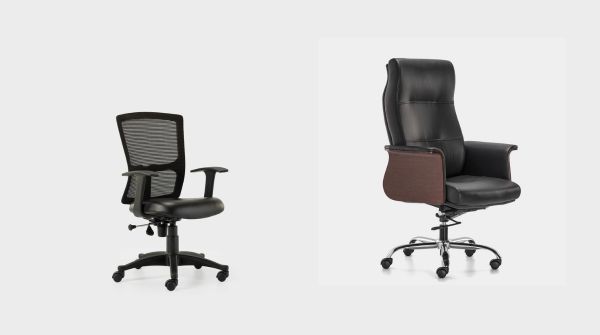
Choosing the right office chair isn’t just about design or price, it’s about how well the chair supports your daily work habits and physical comfort. Every person has a unique working style, which means the ideal chair for one might not suit another. Whether you’re constantly shifting between meetings, seated for long hours at a desk, or frequently moving around your workspace, the kind of chair you select can impact everything from your posture to your productivity.
Let’s take a deep dive into how your work habits should guide you when you shop for office chairs, and how making an informed decision can bring long-term benefits to your well-being and efficiency.
1. Understand Your Work Habits
Before you even begin browsing catalogs or showrooms, take a few days to observe your routine. Are you glued to your computer for hours without moving? Do you often switch between desks or need to swivel from one workspace to another? Are you someone who takes short breaks frequently, walking around to stretch?
Identifying these patterns will provide essential insight into what features your chair must have. A designer who spends long hours at a desk will likely have different needs than a manager constantly getting up to attend meetings or speak to team members.
2. For the Deep Worker: Ergonomic Support Matters
If your job requires intense focus and extended hours of sitting, think writers, software developers, analysts, then ergonomics should be your top priority. Look for chairs with adjustable lumbar support, seat depth, and tilt tension. A well-contoured backrest and breathable fabric can go a long way in preventing fatigue.
When you shop office chairs for deep, uninterrupted work, focus on models that conform to your spine’s natural shape. Adjustability is key; it allows the chair to support your body regardless of posture changes throughout the day.
3. For the On-the-Move Professional: Mobility is Key
Are you someone who is constantly moving from one part of the office to another? Do your tasks involve multitasking across multiple surfaces or workstations? Then, mobility and flexibility become vital.
In such cases, rolling desk chairs can be a great fit. Their smooth, wheeled bases enable easy movement, and when paired with a swivel feature, they can significantly reduce strain caused by twisting or reaching. Choose a model with lockable wheels to balance movement with stability.
Look for lightweight yet durable frames that won’t slow you down as you move from task to task. Chairs with arms that don’t obstruct motion can also add convenience without compromising support.
4. For the Collaborative Worker: Flexibility and Adaptability
If your job involves brainstorming sessions, team meetings, or collaborative tasks that require frequent seating changes, you need a chair that can adapt quickly. Stackable or easily movable chairs might serve well, but if comfort is still a requirement, go for a light ergonomic model with a simple design and decent lumbar support.
Here, it’s less about long-term seating and more about short bursts of use. However, just because the duration is brief doesn’t mean comfort should be sacrificed. A poor seating experience can still lead to discomfort if repeated throughout the day.
5. For the Remote Worker: Home Office Comfort
Remote professionals often have to make do with limited space, which means the office chair needs to be practical, compact, yet supportive. A bulky executive chair may not be the right fit for a smaller home setup.
When you shop office chairs for a home environment, consider aesthetics too, it should fit your home’s décor without sticking out awkwardly. Many rolling desk chairs now come in sleeker designs and muted colors that blend seamlessly into a home workspace.
Look for chairs with quiet wheels, breathable materials, and perhaps a foldable option if your office doubles as a living area.
6. Consider the Chair’s Material and Build Quality
Regardless of your work style, the material of the chair has a significant impact on comfort and longevity. Mesh-backed chairs offer great ventilation, perfect for warmer climates, while leather or faux-leather options provide a plush, executive look and feel.
The build quality determines how well the chair will perform under everyday wear and tear. Choose high-quality castors, a solid base, and robust adjustment levers. Investing in a chair that lasts is always more economical than repeatedly replacing inferior ones.
7. Evaluate Adjustability Options
The best office chairs allow you to fine-tune everything from armrest height to recline tension. This ensures your seating experience is personalized. Features like tilt-lock, adjustable headrests, and 360-degree rotation add versatility.
Adjustability becomes even more important if the chair will be shared by multiple users. In shared workspaces, the ability to easily modify chair settings makes it easier for different people to maintain good posture.
8. Don’t Overlook Aesthetics and Office Culture
While comfort is non-negotiable, your chair also contributes to your work environment’s visual and cultural identity. A minimal, sleek chair suits a tech startup, while a more traditional leather seat might be better suited for a law firm or corporate office.
This doesn’t mean choosing form over function, but rather finding a middle ground. A good-looking chair that meets your functional needs elevates both your comfort and your office’s professionalism.
9. Test Before You Buy (If Possible)
If you have access to a physical store, always try out a chair before making a decision. Sit in it for at least 10 minutes, go through a few common work motions, typing, turning, reaching, and see how it feels.
Pay attention to how your body reacts: Is there any pressure on your thighs? Do your arms rest naturally? Does your lower back feel supported? The answers to these questions can guide your purchase better than any spec sheet.
10. Think Long-Term: Invest in Comfort and Health
The chair you use daily plays a critical role in your long-term musculoskeletal health. A poorly chosen chair can lead to back pain, poor posture, and even long-term complications. The initial cost of a well-designed office chair is far outweighed by the health benefits and productivity boost it offers.
When you shop office chairs with intention and awareness of your specific needs, you invest in more than just furniture, you invest in your well-being.
Final Thoughts
Work styles vary, and so do the needs that come with them. Whether you are constantly rolling from task to task or parked in deep focus all day, there is a chair designed for your rhythm. The key is understanding your own habits and matching them with a chair that supports you, both physically and professionally.
The perfect office chair doesn’t just complement your desk, it complements your day. Make the right choice and let your chair carry your workload a little more comfortably each day.







